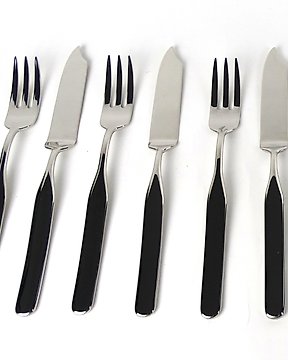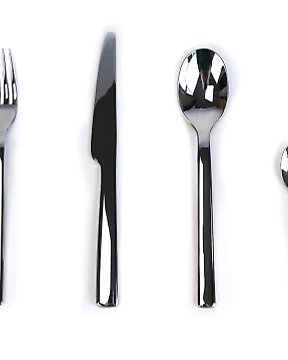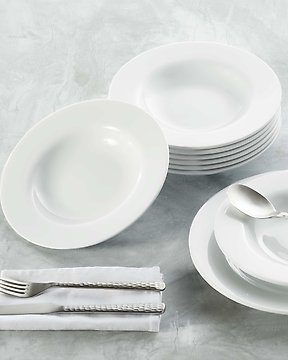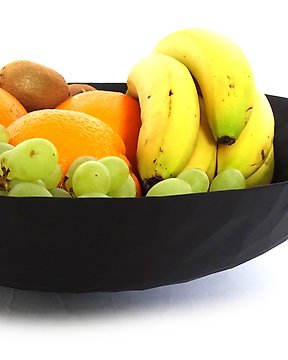Alessi - Jiakun Liu - Tablett - „Jane“ - Eloxiertes Aluminium
Nr. 82708671
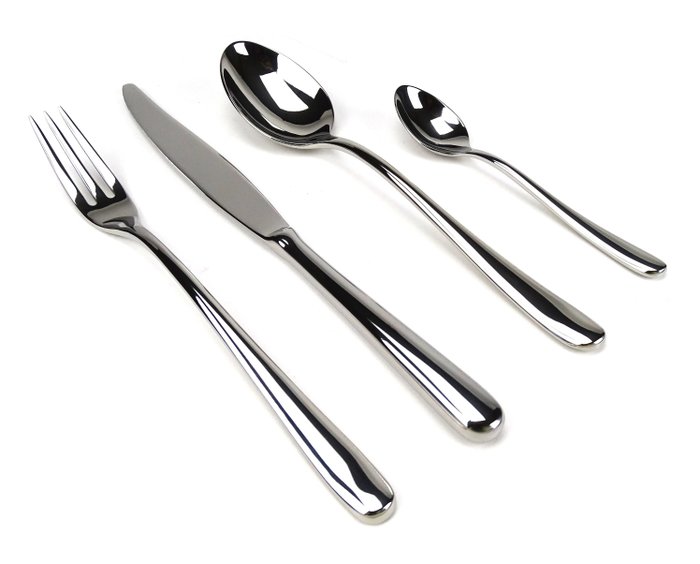
Alessi Luigi Caccia Dominioni, Livio and Pier Giacomo Castiglioni - Besteck (48) - 48-teilig - ''Caccia'' - Edelstahl 18/10
Nr. 82708671

Alessi Luigi Caccia Dominioni, Livio and Pier Giacomo Castiglioni - Besteck (48) - 48-teilig - ''Caccia'' - Edelstahl 18/10
Cutlery set of 48 pieces composed of twelve tablespoons, twelve table forks, twelve table knives and twelve coffee spoons.
Designed in 1938 and presented in silver at the 1940 Triennale, the Caccia series of cutlery - an excellent example of “Lombard classicism” in design - won praise from Gio Ponti for the balance it struck between an image of craftsmanship and the industrial future of household objects. In 1990, thanks to an agreement with the Castiglioni brothers and with Luigi Caccia Dominioni and after extensive philological research to complete the series with the missing pieces, "Caccia" has been reissued by Alessi in 18/10 stainless steel. Resulting in this beautiful cutlery set that is even shown at the Museum of Modern Art of New York.
This ''Caccia'' cutlery set is in unused and new condition. Delivered with original packaging and documentation. The cutlery is dishwasher safe. Please read the manual carefully before using the set.
Luigi Caccia Dominioni:
Born in Milan in 1913, he graduated in architecture from the Polytechnic of Milan in 1936 and in the same year he started his activity in Venice together with Livio and Pier Giacomo Castiglioni, winning the competition held at the Vimercate School. In the field of Industrial design he was considered a "pioneer" when he presented at the VII Triennial in Milan a series of radios designed together with the Castiglioni brothers. In the '50s he set up, together with Gardella and Corradi, Azucena which is a collection of the furniture and objects he designed.
Pier Giacomo Castiglioni (1913 - 1968):
Born in Milan in 1913. Castiglioni studied architecture at the Politecnico di Milano, and graduated in 1937. In that year or in 1938 he started an architectural design practice with his brother Livio and Luigi Caccia Dominioni. Amongst the designs produced by the practice were the first Italian bakelite radio. After the Second World War he and Livio worked with their younger brother Achille. Much of their work was in product and exhibition design, but they also carried out a number of architectural projects, including the reconstruction in 1952–53 of the Palazzo della Permanente.
Livio Castiglioni:
Livio was born in 1911 in Milan, where he graduated in architecture in 1936. Lights, sounds, and audiovisuals were his main interests. From 1940 to 1956 he was a consultant to Phonola and later (from 1960 to 1964) to Brionvega. In 1956 he founded ADI (Associazione per il Design Industriale) with his brothers and was its president from 1959 to 1960. From 1972 to 1979 he was the co-owner of the firm on Via Presolana with his son Piero, and designed lighting projects for several public and private art galleries, as well as for hotels, offices, showrooms, shops, private homes, and temporary shows in Italy and abroad. The special editions of their lighting appliances, crafted on a small scale, included the Scintilla lighting system.
He designed for several companies, including Artemide, Fontana Arte and Stilnovo.
Das könnte Ihnen auch gefallen
- 16+
Dieses Objekt wurde vorgestellt in:
So kaufen Sie auf Catawiki
1. Etwas Besonderes entdecken
2. Höchstgebot abgeben
3. Sichere Zahlung durchführen

